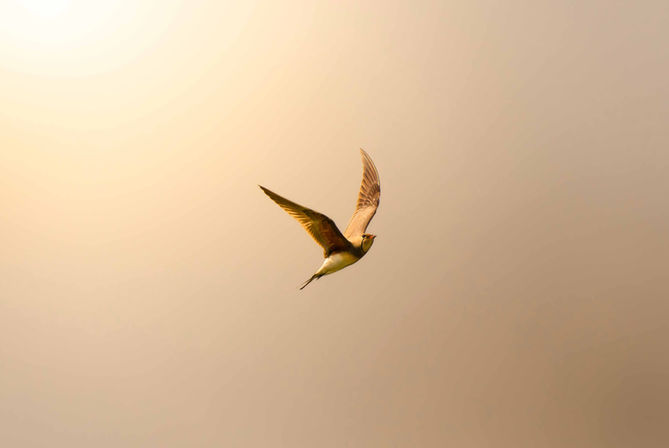

EVOA, Lisbon, Portugal, April, 2023.
The Bird
Graceful in flying, and pleasant to listen to, the Collared Pratincole is a bird which makes you dream if you see it. It does get part of the name from a clear black “collar” which separates its main brown plumage to a cream-coloured patch under its beak. It has long, narrow wings, a deeply forked tail, short legs and a short bill. Its brown colour pattern makes it easier to distinguish from Terns, which have a similar shape and way of flying.
Migration
The Collared Pratincole breeds in the Mediterranean region, Middle East, Southwest Asia, Afghanistan, southern Europe, Pakistan and northwest India; migrating southwards for wintering in the savannas of the Sahel region in central Africa and also eastern Africa.
They are highly gregarious and roost in flocks in wintering habitat and return to breeding colonies in late February. Some of the populations in central, eastern and southern Africa are resident or nomadic, possibly they have lost the need to travel many kilometres away to have a better life just by staying, a possible reason being less competition for food.
Post-breeding the juveniles may disperse and establish new locations within the range before heading for the first time to Africa.
The Sound
A two-tone call, short and sharp kiev or kip frequently used with a rolling kivik-kirrrrrrr, with the latter part slightly descending.
- Use the Player to listen to the call. -
Its distinctive sound though is a short melody pretty much always the same, much clearer and joyful than Common Terns, which at first could sound quite similar.
- Use the Player to listen to the Common Tern call. -
Habitat
This species breeds on flat open areas with short or patchy vegetation such as fields, steppe plains near water the margins of alkaline lakes and dried mudflats in Eurasia. In Africa, it frequents ploughed fields, recently burnt open ground, overgrazed grassland, and sandflats usually along the edges of larger rivers and estuaries. It may also forage over water, in rice fields or in coastal scrubland, occurring along coasts, at reservoirs or desert oases on migration.
- Use the Player to listen a full hour of ambient soundscape. -
Our Encounter
We saw two Collared Pratincoles when in Camargue, in July 2022, for no more than a minute; Ario saw them, Axel didn’t really, and Clemence also did and the excitement was high. We just want to thank Clemence for her help in the Camargue, she joined us for a month, believe in what we wanted to do and was curious to explore the Camargue more with us, even though she’s from the area. She’s an amazing naturalist and nature educator based in southern France, travelling and living off her VW T3, classy!
Back to the Collared Pratincoles, we knew EVOA has a strong population, but you never know how birds behave, they may show up one year, or later in the year, or even earlier.
We arrived at EVOA in late March 2023, spring was in full swing with flowers everywhere, buzzing bees and birds getting louder each passing morning.
First sight! We saw and heard three or four Collared Pratincoles flying around the visitor centre for a short period of time. They’re coming and EVOA has the perfect spot for them, a small island in the middle of the first lake just in front of the visitor centre, it was just a matter of waiting.
After a couple of weeks spent at the reserve, most of the main migratory birds coming from West Africa, we’ve heard our first Great Reed Warbler, Savi’s Warbler, and numbers were increasing by the day, but the Collared Pratincoles were still at low numbers. But one weekend they arrived, a stronghold of 30 or more birds started taking over their island, filling up the air with their calls, making the sky look even lighter and dreamy with their slow-mo-like flying style.
They have been active since then, settling in, and choosing their nests, and we couldn’t be more mesmerised by their beauty; it was time to get some recordings and videos. We noticed they would sometimes fly really low on the top of the dyke between the lake they stayed in and the visitor centre, meaning that would have been a great place for a 360 shot. Ario decided to put his camouflage vest on and stay there waiting with the 360 camera in his hand on a high pole above his head. He did manage to get a good shot, but they are so fast it can be tricky to see them. You can see the video in 360 in our EVOA Immersive Experience on Youtube.
EMBED VIDEO
Axel did something similar to capture the sound, placing the microphone near the reed where he noticed the birds would fly over when leaving the nesting island. The “Long Soundscape” audio in the Habitat section above is an extract from that location.
Our time at EVOA was really special, and the Collared Pratincoles made it even more wonderful, thank you Andreia, Sandra and the EVOA team for being so welcoming and supporting “Wings Across Continents” by letting us stay in the reserve literally 24/7 for the entire month we spent there.
10% of the profit from the Collared Pratincole postcard and print goes to EVOA, Portugal, where these pictures, videos and sounds have been taken from.
Sources
https://www.birdid.no/bird/eBook.php?specieID=1083
http://datazone.birdlife.org/species/factsheet/collared-pratincole-glareola-pratincola/text
https://www.vogelwarte.ch/en/birds/birds-of-switzerland/collared-pratincole




